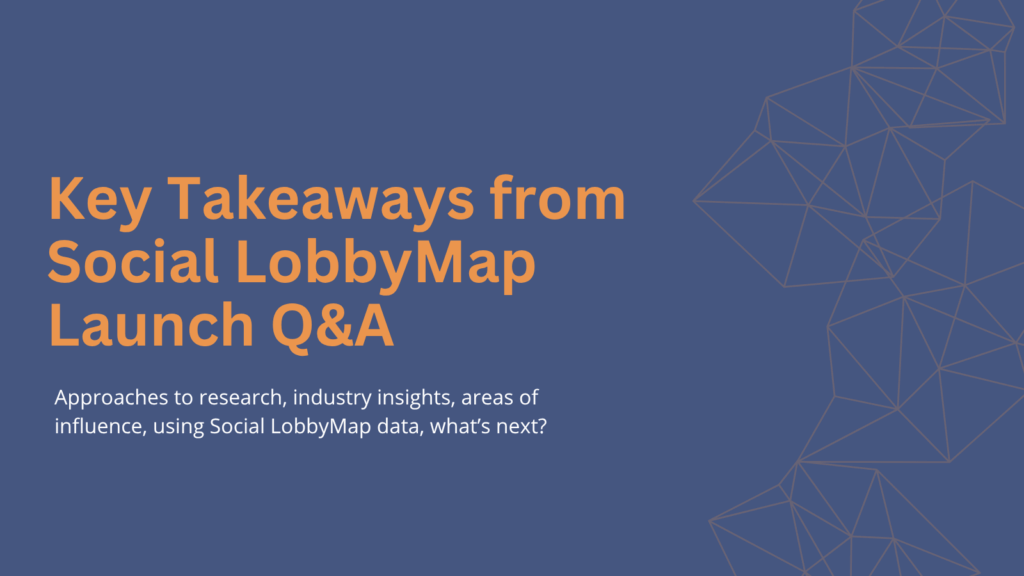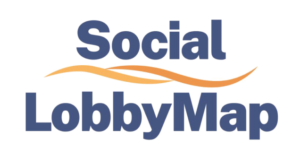
Social LobbyMap’s latest research launched in June with a webinar to explore the data analysed. Alongside experts in the industry, SLM researchers discussed the findings and answered key questions from companies, CSOs and investors, covering approaches to research, industry insights, areas of influence, using the data and what’s next for SLM.
How easy was it to find data for all the corporate entities you assessed? What was the % of data gaps and how do you score companies where there is no data?
It comes with the territory of lobbying that there are always going to be data gaps. There are so many ways this engagement can happen that makes it impossible to capture everything. But there is information out there and it is good information that can be utilised in research such as SLM. The content of official consultations are publicly available. Trade associations aren’t particularly shy in publishing their position papers. There’s a lot you can already find without going into the more investigative work of freedom of information (FOI) requests, for example. When you get to end of road with immediately public info you can go into deeper info. It gets trickier because it takes time to get responses. But the information which is generally accessible is often quite telling, before the additional information is even considered.
Is the apparel sector less engaged because they are generally more advanced on supply chain due diligence?
There’s little way of being certain about why any particular sector is less engaged. We’ve had conversations with other experts who feel that in general, a lot of business actors feel like silence is support. It’s likely that apparel sector felt this way – taking the stance that if they’re not actively speaking out against something, they’re in favour because they’re not voicing opposition. But when it comes to human rights due diligence (HRDD), it’s important for business entities to ensure their voices are heard – whether through their own lobbying or that of the trade associations of which they’re members.
This said, because of the data gaps mentioned above and as highlighted during the SLM launch webinar, there may have been apparel actors who have gone through lobbying channels we haven’t covered/been aware of.
Generally how effective is trade association lobbying in influencing social policy? Does this differ by region? Are they generally more influential and engaged than companies themselves?
It’s important to note that, just as SLM isn’t against lobbying, SLM isn’t against trade associations. They play an important role in business. Having someone in Brussels, or other legislative locations, on your behalf watching and listening is a legitimate and useful role for businesses. But it can be that some trade associations have hugely disproportionate influence.
Often, within a trade association, it is the “lowest common denominator” which is pursued. Attention is usually paid to the company banging on door complaining the most or the loudest. As a result, trade associations aren’t particularly successful at representing the majority.
With that comes the importance of business entities using their voices. It’s crucial for businesses to use their voice. The research suggests many companies have felt that if they’re not explicitly opposing, they are demonstrating support. But remaining silent also has an impact.
SLM can ensure a more balanced debate with all voices being heard – not just the loudest members who are banging on the door.
Who are the most influential trade associations around social policy?
It’s difficult to say which trade associations are more relevant or powerful, but we have heard many stories of papers being submitted by trade associations which find their way, without many amendments, into the directive. At SLM, we believe that this approach should be challenged and should be more transparent and we should be aware of not only who those trade associations are but who are their members and the impact of that. Transparency on all parts of the process around trade association lobbying is very important.
How can asset owners start incorporating Social LobbyMap as an indicator to assess their managers on fulfilling their human rights commitments?
There’s a clear case for asset owners to be asking their managers to discuss their relationship score and explore how their company performed in the SLM. The methodology, and the thematic areas within that, can also be a useful tool to inform the way asset owners are assessing managers on their stated commitment to human rights. Adapting those questions can help monitoring managers – whether that’s using due diligence questionnaires, while asking managers if, how and where they’re using data from SLM in their stewardship activities can create transparency and ensure they’re held to account regarding their stated commitment to human rights.
How granular is the information compiled due to the fact that human rights abuses should be understood as much by the context and events, as well as equally by the process which have been undertaken in decision-making?
The Social LobbyMap indicators attempt to reflect the necessary granularity of the intersection of business and human rights. While there are other relevant thematic areas in that field that we’re not yet covering, the research is focusing on the basic requirements of human rights due diligence, access to remedy, value chain coverage and stakeholder engagement. This includes both questions of business governance and business practice.
Our nine key indicators are based on international standards, such as the United Nations Guiding Principles on Business and Human Rights (UNGPs). These indicators reflect what requirements a human rights due diligence legislation should have to be aligned with these standards while still being broad enough to be applied to legislative proposals globally.
What are some of the key differences/challenges of assessing company lobbying activities on “social” policy vs climate?
‘Climate’ has the advantage of being able to refer to a single guiding document, the Paris Agreement. ‘Social’ on the other hand does not have a corresponding single international standard. While the UNGPs and the OECD Guidance for Multinational Enterprises are providing a baseline understanding for business and human rights, the area of ‘social’ comprises many more aspects that these documents do not address.
We have to consider this ‘diversity’ on the development of our methodology in order to develop more suitable metrics and indicators to reflect ‘social’ lobbying. For example:
- Defining the scope and the areas of ‘social’ that we will analyse, which is based on consultations with stakeholders; and
- Making our methodology more granular, adding the indicator level analysis, to be able to capture relevant lobbying positions.
How have you involved the companies and entities you have assessed as part of this project?
Offering organisations a chance to see their assessment and respond to it is a big part of our ethos and approach to transparency across all our projects. We invite companies to comment on the research before we release the results publicly and after publication, companies can appeal the information shared. All appeals are reviewed by our team and can be escalated to our methodology committee (if necessary).
What are the next steps for SLM in terms of legislations to be covered next/ expansion of coverage? Can you expand on how you will be assessing companies lobbying practices on other policy/legislation and what the time frame for this is?
We don’t currently have all the ins and outs and details of the political engagement that is happening in the world but it’s crucial to recognise that corporate lobbying is not limited to the climate. Over the coming months, we have a few smaller analyses which continue to explore the impacts of lobbying on social policy.
Our next focus will be on the Mining sector – covering a group of 25 companies and a small number of trade associations –PRI Advance Initiative, coming in September 2025., coming in September 2025.
We will also be exploring the Omnibus assessment, examining how the debate is being shaped and through the lobbying of which organisations, trade associations and sectors. This project will also cover the five years of the CSDDD.
In November, we’ll be launching our research into labour indicators, examining small policies and small legislations, which are equally as important and impactful, but perhaps not as wide in breadth as the CSDDD.
Finally, for the coverage going forward, we have more topics in mind and plan to cover more companies, sectors and thematic areas. We very much encourage interested parties to get in touch to help us shape the scope of the project moving forward.
